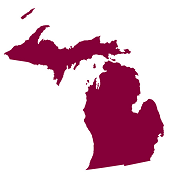Michigan’s Ongoing Stroke Registry to Accelerate Improvement of Care (MOSAIC)
‹View Table of Contents

From 2012 to 2015, Michigan’s Ongoing Stroke Registry to Accelerate Improvement of Care (MOSAIC) achieved significant improvements in the percentage of patients for whom an NIHSS score was recorded (82% to 91%, P < .0001) and who were provided with stroke educational materials (86% to 95%, P < .0001) in 26 hospitals through monthly conference calls on best practices and one-to-one technical assistance for hospitals.
History of Stroke Care in Michigan
During 2007–2012, the Michigan Department of Community Health received funding from the CDC Paul Coverdell National Acute Stroke Program to improve care for stroke patients in hospitals participating in MOSAIC. The Michigan Department of Community Health’s experience with in-hospital stroke care and prior pilot work on hospital-to-post-hospital transitions of care provided the program with the organizational capacity needed to receive 2012–2015 Coverdell funds to continue its work.
Program Implementation for MOSAIC from 2012–2015
MOSAIC’s main QI activities were (1) continuing or maintaining improvement on key inpatient stroke care measures and (2) conducting a pilot program of making 30-day follow-up calls for all patients discharged.
Improving Outcomes Among Michigan Stroke Patients
MOSAIC’s QI efforts contributed to systems and practice changes in hospitals participating in the 30-day follow-up call pilot. For example, at one participating hospital, follow-up call data revealed that patients were not meeting lifestyle and medication regimen recommendations. To overcome this challenge, the hospital began providing free medication counseling services that focused on working with the patient and caregiver to set up a medication regimen before discharge.
MOSAIC’s activities also contributed to better quality of care for stroke patients. Performance measure data from the state stroke registry of participating hospitals revealed improvements in 4 of the 12 key Coverdell Program quality-of-care measures from 2012 to 2015 (Table 1). The two measures that made the largest increases over time were the percentages of patients provided with stroke education at discharge and for whom an NIHSS score was recorded, which both improved 9%.
Table 1. Improved Coverdell Program Quality of Stroke Care Measures, 2012–2015
| Measure | 2012 | 2015 | P |
|---|---|---|---|
| Venous thromboembolism (VTE) prophylaxis | 97% | 99% | <.0001 |
| Stroke education | 86% | 95% | <.0001 |
| Discharged on statin medication | 91% | 93% | <.0001 |
| Recording of NIHSS score | 82% | 91% | <.0001 |
Future Directions for Stroke Care in Michigan
MOSAIC’s future work will focus on continuing the record of success with inpatient and post-hospital stroke care, as well as informing the passage of guidelines to establish a statewide stroke system of care, including hospital designation for primary stroke centers. MOSAIC plans to expand the patient discharge 30-day follow-up call process and resulting system changes to additional Coverdell hospitals; however, they are largely dependent on Coverdell funding for stroke care programming. MOSAIC received 2015–2020 Coverdell funding to continue its work in stroke care.
Additional Information
Acronyms Used in the Summaries
CDC: Centers for Disease Control and Prevention
EMS: Emergency Medical Services
NIHSS: National Institutes of Health Stroke Scale
NQF: National Quality Forum
QI: Quality Improvement
Other Terms Defined
Primary Stroke Center: The Joint Commission’s Certificate of Distinction for Primary Stroke Centers recognizes centers that make exceptional efforts to foster better outcomes for stroke care. Achieving certification signifies that the services provided have the critical elements to achieve long-term success in improving outcomes. The certification is based on the Brain Attack Coalition’s “Revised and Updated Recommendations for the Establishment of Primary Stroke Centers” and includes the requirement to report on eight core standardized measures from the Joint Commission.
For more information on the current program, visit the Paul Coverdell National Acute Stroke Program website.
For questions about the evaluation of the program, e-mail arebheartinfo@cdc.gov.
State Summaries
- Arkansas Stroke Registry
- California Stroke Registry/California Coverdell Program (CSR/CCP)
- Georgia Coverdell Acute Stroke Registry (GCASR)
- Iowa Coverdell Stroke Program (ICSP)
- Massachusetts Coverdell Program
- ›Michigan’s Ongoing Stroke Registry to Accelerate Improvement of Care (MOSAIC)
- Minnesota Stroke Registry
- New York Coverdell Program
- North Carolina Stroke Care Collaborative (NCSCC)
- Ohio Coverdell Stroke Program
- Wisconsin Coverdell Stroke Program (WCSP)
